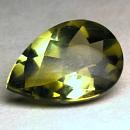|
Click on a letter above to view the list of gems. |
|
|
|
|
|
|
|
|
Prasiolite
(variety
of Quartz) |
|
| | |
| Discovered in Prehistory; IMA status: Not Valid (trade name). | ||
|
| ||
|
Chemistry |
| ||||||||||||||||||||
|
| |||||||||||||||||||||
|
SiO2 + Fe2+ | |||||||||||||||||||||
|
|
Silicon Dioxide + Iron | ||||||||||||||||||||
|
Molecular Weight: |
60.08 gm (Quartz) | ||||||||||||||||||||
|
Composition: |
| ||||||||||||||||||||
|
|
|||||||||||||||||||||
|
|
|||||||||||||||||||||
|
|
|
Classification |
|
|
| |
|
Oxides | |
|
4/D.01-10 | |
|
|
4 : OXIDES (Hydroxides, V[5,6] vanadates, arsenites, antimonites,
bismuthites, sulfites, selenites, tellurites, iodates) |
|
Related to: |
Quartz Group |
|
Synonyms: |
Green Quartz |
|
|
|
|
Crystal Data |
|
|
|
|
|
Widely variable; but typically long prismatic with steep pyramidal terminations, but may be short prismatic to nearly bipyramidal; fibrous (Agate & Chalcedony) |
|
|
Very common, penetration twins on the Dauphiné law, about [0001], and the Brazil law, with [1120] as contact plane; contact twins on the Japan law, with [1122] as contact plane, may be repeated; and several other laws. |
|
|
|
|
|
Physical Properties |
|
|
|
|
|
[0110] Indistinct |
|
|
Conchoidal |
|
|
Brittle, tough when massive |
|
|
7.0 |
|
|
2.60 - 2.65 (g/cm3) |
|
|
may be Triboluminescent |
|
|
Not Radioactive |
|
|
Other: | |
|
|
|
|
Optical Properties |
|
|
|
|
|
Medium to Dark Green, Olive Green |
|
|
Transparent to nearly Opaque |
|
|
Vitreous, waxy to dull when massive |
|
|
1.540 - 1.553 Uniaxial ( + ) |
|
|
0.0090 |
|
|
0.013 (low) |
|
|
None |
|
|
|
|
|
Occurances |
|
|
|
|
|
Geological Setting: |
In hydrothermal veins, epithermal to alpine; characteristic of granites and granite pegmatites; in sandstones and quartzites, less abundant in other rock types; in hydrothermal metal deposits. Common in carbonate rocks; a residual mineral in soils and sediments. |
|
Common Associations: |
Calcite, Chlorite, Epidote, Feldspars, Fluorite, Micas, Zeolites, many other species. |
|
Type Locality: |
n/a |
|
Year Discovered: |
Prehistoric |
|
View mineral photos: | |
|
|
|
|
More Information |
|
|
|
|
|
|
Mindat.org
(Quartz) |
|
|
|
|
Most Prasiolite gems on the market are irradiated or heat treated Amethyst. These heated gems are often refered to as "green amethyst" or "vermarine" but are not true Prasiolite. Naturally occuring Prasiolite is actually quite rare. Natural Prasiolite gets its green color from iron (Fe2+) compounds in the chemical mixture. Some colorless quartz crystals contain green Chlorite inclusions or phantoms. These would not be considered Prasiolite however. Natural
Prasiolite crystals are known to be found in Southern Bahia and
Minas Gerais, Brazil; and Lower Silesia in Poland. |
|
|
We
have not photographed our Prasiolite gems
yet. Please
check back soon. |

